- Bernard Preston homepage
- Solar geek
- West Facing Solar Panels
West facing solar panels
West facing solar panels are something of an anathema; most folk whose roofs are oriented east-west find the subject very frustrating. They cannot easily build a photoelectric farm on their homes.
In theory the panels should be north or south-facing, depending in which hemisphere for the most direct sunshine.
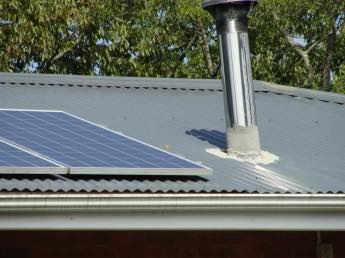
This page was last updated by Bernard Preston on 20th April, 2021.
Which way should they face anyway?
As a result of the post below about east-west facing solar panels in Holland, I have given the matter some considerable thought. In all honesty, there is a huge difference of opinion on the subject.
With 5kW of north facing panels, we have enough at midday, but too little in the morning and late afternoon. So contrary to popular opinion, we have added another 2.5 kW directed to the east and the same looking west.
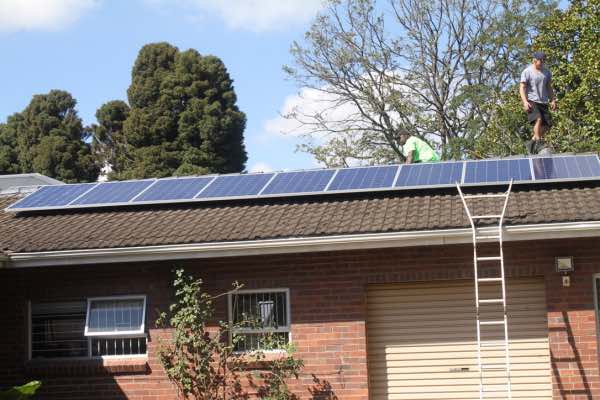
In total we now have a little over 10 kW of panels. This is perhaps a bit of a luxury, but we are planning to add our daughter's home on the same property to our solar farm.
A recent 431 volt surge from the
utility down our street did massive damage, so there are also thoughts
of going off the grid. We are also waiting for a no-frills electric
vehicle to come onto the market.
The panels are up, the new lithium batteries and two 100 amp MPPTs are installed. We will keep you posted on progress with our east and west-facing solar panels.
- Bernard Preston homepage
- Solar geek
- West Facing Solar Panels
I was on a jaunt in the Netherlands in 2016, when I first found that homes there have taken on east and west facing solar panels. Whilst not as effective as a PV directed to the south in this northern hemisphere city, they produce a far greater than expected output.
So why would you deliberately face your panels in a westerly direction where they only get direct sun for half the day?
There is a simple explanation; you have sufficient power from your panels for most of the day, but not enough in the late afternoon when cooking the evening meal is starting to happen.
For that matter we now also have east-facing solar panels to catch the early morning sun. This in fact happened in 2019 with an extra 2.5 kW supplying energy for morning coffee and cooking Eggs Hilton.
The first dilemma is whether you have a suitable west-facing roof that is not going to be shaded by a tree or chimney.
Partial shading used to be a huge problem such that if one panel falls completely in the silhouette of branch, say, none of the PVs in series will function at all.
Remember too that shadows on PV panels will change in summer and winter; not only lower in the sky during the darker days, but also north and south.
Ensanguining the skies
How heavily it dies
Into the west away;
past touch and sight and sound
Not further to be found
How hopeless under ground
Falls the remorseful day.
- AE Housman.
West facing solar panels
These west-facing solar panels on a typical Dutch-duplex are their only option, not having a roof with a southern orientation. Notice there are two different size panels; this can only be done if you know how diodes work.
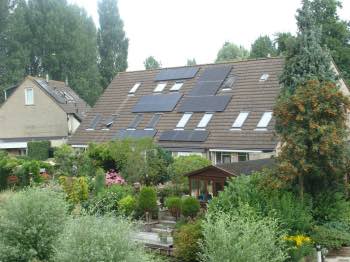
So, during the day, we have more than enough energy coming in from Mr Golden Sun to supply the pool pump, the kettle and the oven; the bread-maker, dishwasher and the electric lawnmower too.
But come 4pm when the sun is falling obliquely on the PVs, and the incoming energy falls below 1kW, there's not enough electricity to cook the evening dinner; enter west-facing solar panels.
Those west-facing panels do not need to be oriented at 30 odd degrees, like those that are on the north slope of your roof. In fact they can be quite close to vertical. They will produce less energy before midday, but after 1pm they will start to supply electricity just as the others begin to fade.
There is an alternative. One could add more batteries to store that electricity coming in during the day; but good quality is very expensive. It would mean another R45,000, or roughly $3,000 for a 7kWh lithium-ion.
There is another alternative; tie onto the grid, but that is still illegal in many parts of South Africa and means no power from the sun if the grid goes down, unless you have batteries and a second inverter.
Grid tied inverter technology is rapidly improving, and that remains an option for the future.
Instead we have opted to use a change-over switch that enables one to toggle from the grid to solar, depending on the weather and at night; it works well, and I recommend.
Most of the time the mains breaker remains firmly in the off-position reducing the risk of surges from the utility, a huge problem in South Africa.
Newsletter
Our newsletter is entitled "create a cyan zone" at your home, preserving both yourself and Mother Earth for future generations; and the family too, of course. We promise not to spam you with daily emails promoting various products. You may get an occasional nudge to buy one of my books.
Here are the back issues.
- Lifestyle and ideal body weight
- What are ultra-processed foods?
- Investing in long-term health
- Diseases from plastic exposure
- Intensive lifestyle management for obesity has limited value
- A world largely devoid of Parkinson's Disease
- The impact of friendly bacteria in the tum on the prevention of cancer
- There's a hole in the bucket
- Everyone is talking about weight loss drugs
- Pull the sweet tooth
- If you suffer from heartburn plant a susu
- Refined maize meal and stunting
- Should agriculture and industry get priority for water and electricity?
- Nature is calling
- Mill your own flour
- Bake your own sourdough bread
- Microplastics from our water
- Alternative types of water storage
- Wear your clothes out
- Comfort foods
- Create a bee-friendly environment
- Go to bed slightly hungry
- Keep bees
- Blue zone folk are religious
- Reduce plastic waste
- Family is important
- What can go in compost?
- Grow broad beans for longevity
- Harvest and store sunshine
- Blue zone exercise
- Harvest and store your rainwater
- Create a cyan zone at your home
Lateral thinking
Lateral thinking is always important in life; it's always difficult to reject a half built project, but it's better than sitting with a problem for ever and aye.
Finally I made the decision to put the panels where they should have gone from the beginning; on the roof. Because it was high, and slippery, I was against the idea because I wanted to do it all myself; pride cometh before a fall.
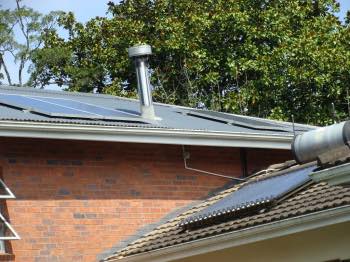
The cost of having a local company fit these west facing solar panels was much less than I expected; and I didn't have to risk my neck.
In 2017 they were the largest panels I have ever seen; 310W each, providing an extra 930 watts.
Now in 2022 there are 545W PVs.
The most surprising feature, despite the fact they are west-facing, is that by 9am they are already contributing.
But the real benefit of over-supply is that every time a cloud passes over the sun, I no longer have to rush inside and turn off appliances. And on a marginal overcast day of we still have more than enough energy for computers, and to fill the batteries for lights at night.
The other major benefit of course is that late in the afternoon, these west-facing solar panels are pumping in a lot more power, directly oriented to the sun.
One other consideration is that it has meant adding an extra MPPT controller. They can only handle 60 amps each, and the new west-facing panels exceeded that maximum.
East facing solar panels are something for the future; instead I've opted for these mobile panels; by turning them to follow the sun they supply 60% more energy.
Burned connector
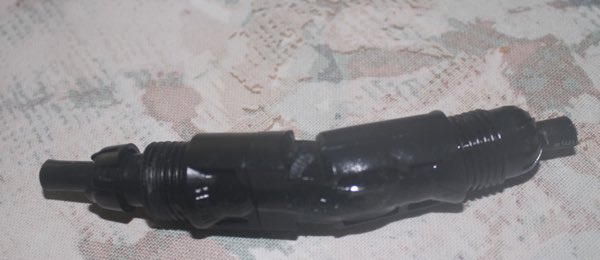
Our West facing solar panels have never quite worked up to expectation; I've assumed it was because they were not directly facing the sun for much of the day, but even in the late afternoon, our mobile solar panels were better.
Now we know why; for no rhyme or reason, after three years, this connector malfunctioned, overheated to the extent that the plastic melted, twisted, and stopped conducting.
There was still voltage being registered at the MPPT, but no current. Initially I thought the regulator had been hit by lightning, but no, this is a factory fault, and luckily quickly found. It really was pretty obvious.
I could have used another connector, but decided to go straight to a ferrule to join the two wires. To be certain of a good connection, I then soldered the connector.
Our west facing solar panels are now performing better than ever. This could have been disastrous starting a fire in the roof; it ended well.
Mobile solar panels
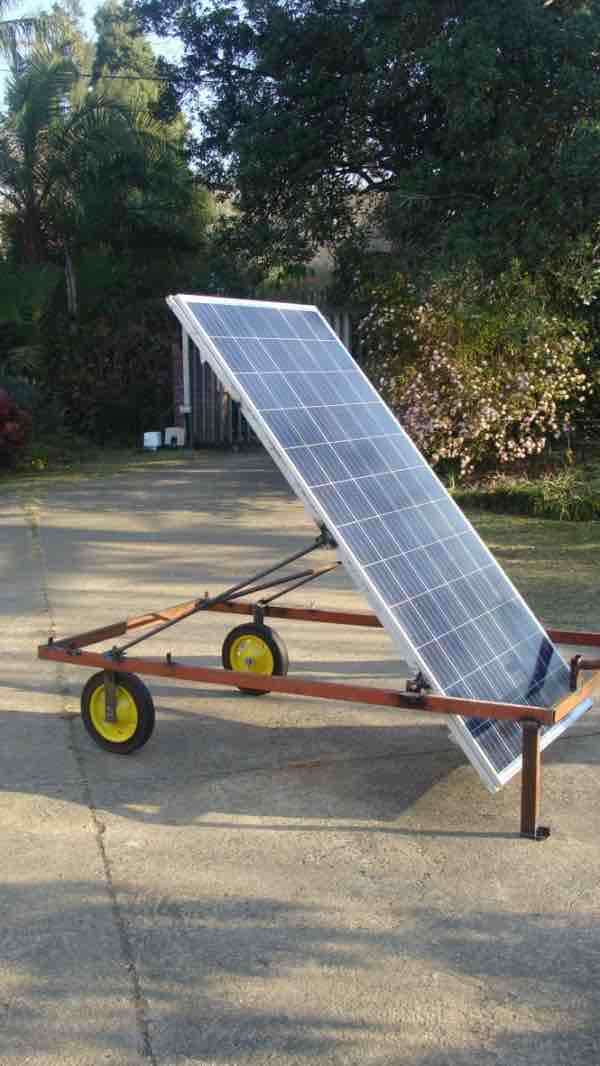
Mobile solar panels, allowing you to follow the sun manually, are in the making; I'm anticipating about double the energy, but it does mean being around our eco-home to turn them two or three times a day.
Note the shadows on the panel; I have modified the legs.
At this stage it is a bit of an experiment; there will be an update in the future. There is never a dull moment in retirement for manic, attention deficit Bernie. He should be on Ritalin, except that his other passion is for a life without medication.
It turns out that these mobile carts, looking to the east in the early morning, north around noon, and west facing solar panels in the afternoon produce 1.6 times the power of stationary PVs. Not only the direction varied but also the inclination of the PVs according to the time of day, and the season.
Since upgrading to an E-car in 2020 these mobile panels have certainly made a difference. It is such a pleasure not having to buy petrol and simply be able to plug into solar energy. The E-car has landed.
MPPT
You should not use the same MPPT for north, east and west facing solar panels. The voltage of the various strings, oriented differently to the sun, will be quite different, and that will confuse the regulator.
In any case, once you get to adding either east or west facing solar panels, or both, you'll be needing an extra MPPT. You shouldn't have more than two strings on one controller apparently, both oriented in the same direction but, not knowing that at the building of this solar generator, I confess I have three and it's working fine. It is probably not the right thing to do.
Ideally I would be thinking of about 5kW of north facing solar panels, or south in your hemisphere, and perhaps half of that oriented to the east, and and the same to the west to provide late afternoon energy. Choosing the correct solar charge controller MPPT is important.
If I was considering a large mobile array at ground level that could be turned manually to follow the sun it would need only one MPPT. I would angle them at say 45 degrees to maximise the early and late radiation.
Solar power energy
Our solar power energy arrays have been added to gradually; initially it was derived from 3.2kW of panels on the north roof, plus an extra 930W from the west facing solar panels, and another 930W from the mobile carts. This should have supplied most of our needs; it did as long as the weather was fine.
Then we started exporting power to our daughter's home, and have the extra east and west-facing panels, totally 10kW altogether.
I did this primarily so that we would have power when the grid fails, which it does regularly in South Africa, and to contribute to a greener planet, a pristine place in the sun for our grandchildren, as we enjoy. The reality is though that our solar generator has nearly paid for itself; the utility has applied for an astronomic 33% increase in 2018; then we will be entirely in the black.
As I write Eskom has applied for another 20% increase in 2022. The large amount of money we have spent on solar power energy has been vindicated.
The extra MPPT allows for the addition of east facing panels in the future to catch the early morning sun when energy is needed for the coffee machine and toasting our low GI bread.
Making our own bread daily is another passion; it takes only five minutes each day, and provides us with real 100% wholemeal flour, something almost impossible to purchase. Browse this site if you're interested.
Bernard Preston
Bernard Preston is something of a backyard permaculture freak. That means working with nature rather than against it; harvesting the sun's energy and rainwater, and growing his own fruit and vegetables free of chemicals is just one small part of the whole. West facing solar panels are a late development.
It's to augment the need for more energy in the late afternoon and was something of an experiment, and has been remarkably successful.
Building eco friendly homes has been a wonderful ride; in convenience it's paid for itself many times over, but in terms of hard cash you are looking at about 10 years for a return on your investment. How do you measure the extra years added to your life, building a home like this in your retirement when most elderly folk are putting their feet up?
When browsing use right click and Open Link in New Tab, or you may get a bad gateway signal.
Did you find this page interesting? How about forwarding it to a friendly book or food junkie? Better still, a social media tick would help.
- Bernard Preston homepage
- Solar geek
- West Facing Solar Panels
Address:
56 Groenekloof Rd,
Hilton, KZN
South Africa
Website:
https://www.bernard-preston.com